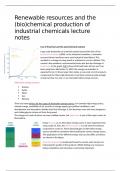Renewable resources and the
(bio)chemical production of
industrial chemicals lecture
notes
Use of fossil fuel and the petrochemical industry
Large scale production of chemicals started around the time of the
industrial revolution (1800). In the industrial revolution, a transition
occurred where machines were used instead of hand labour. This
resulted in a change of using wood as a biofuel to coal as a biofuel. This
caused a few problems: environmental issues but also the shortage of
fossil fuels. In the graph: A1F1 shows that fossil fuels will run out if we
keep using them like before. In 2050, the energy consumption is
expected to be 2-3 times larger than today, so we need a lot of energy to
compensate for these high demands. Fossil fuels cannot provide enough
energy (as they run out), so we need alternative energy sources.
Alternative energy sources:
Nuclear
Hydro
Wind
Sun
Biomass
There are many drivers for the usage of alternative energy sources, for example high energy prices,
climate change, availability of oil, security of energy supply, geo-political conditions, rural
development and innovation. Besides fossil fuel shortage, it also becomes more and more dangerous
and challenging to retrieve oil from the ground.
The changes in crude oil prices can have multiple causes, but global war is one of the major causes of
fluctuations.
Using biomass as an alternative energy source is more expensive than
using crude oil. Also, the efficient land use is a lot lower for biomass
compared to crude oil. These disadvantages of alternative energy
sources should be considered when picking the correct energy source.
The applications of the different energy sources also differ, and these
are shown in the figure.
Rural development is usually performed to receive extra income via
improving the quality of the products. Whilst finding new resources,
being competitive and innovative is extremely important.
, The images show the production processes
of petrochemicals (bottom image) and the
oil refinery. Long chain carbohydrates are cut
into smaller pieces in the steam cracker due
to the high temperature. Ethylene produced
in the petrochemical production, can be
used to produce polyethylene. Polyethylene
can be used for plastic bottles.
The ethylene produced can also undergo
several chemical processes, which are shown
in the image below.
The use of chloride is very toxic. Ethylene and
oxygen together (epoxides) results in the
production of a lot of carbon dioxide. Epoxides are
very reactive, inflammable, and toxic and are
therefore hard to use in the chemical industry.
A similar image as for ethylene can be made for propylene. Ammoxidation can be performed with
polyethylene to produce acrylonitrile (found in LEGO blocks). Ammoxidation is hard as the oxygen
molecule needs to be placed at the exact right position. Acrylonitrile as a monomer is very toxic, but
when processed to a polymer (in LEGO), the toxicity disappears.
These platforms and images show that to make the desired end product, a lot of steps are needed,
which include toxic and inflammable steps. So, it would be nice to circumvent these steps. Catalysis is
used at every stage of the process. A catalyst is a compound which enhance the rate of a chemical
reaction without being destroyed or incorporated into the product (no effect in equilibrium). The
catalyst offers an alternative energy pathway to make the reaction more rapid. Advantages:
No excess of reagents are needed
There is a better atom efficiency (less waste)
Reactions are faster and more selective or reactions can proceed that normally cannot
proceed without a catalyst.
Precious metals are often used as a catalyst, but they become more expensive as precious metals are
rare. Developments take place to use non-noble metals, but the usability and stability as well as the
stability and activity in water should be increased to use them.
, Currently, biomass is used for a couple of things:
Food (including feed)
Wood, paper and cotton
Wood for cooking
More biomass is needed for the production of
chemicals, and only increasing the biomass yields will
not satisfy the demands. To investigate how biomass
can be used to produce chemicals, a lot of money is
needed.
Bio-refining: sustainable processing of biomass into a spectrum of
bio-based products (food, feed, chemicals, materials) and bioenergy
(biofuels, power and/or heat).
Based on the costs from the biomass, it is better to use biomass for
the production of chemicals, since the production of chemicals using
fossil fuels is also very expensive. Electricity, heat, and transport fuels
can be cheaply produced using fossil fuels and biomass cannot
compete with this.
To produce 1 tonne of chemical product, it roughly takes 60 GJ of energy (the energy content of
63000 Mars bars). The energy is here given via a typical fossil fuel production route. Details are
shown in the table below.
Petrochemical route Amino acid route
Calorific value fossil feedstock (ethylene) = 22 Calorific value fossil feedstock = 0 GJ (calorific
GJ value serine feedstock 26GJ)
Total process energy for all process steps = ca. Total process (fossil) energy for all process steps
38 GJ = ca. 18.5 GJ
Total (fossil) energy use = ca. 60 GJ Total (fossil) energy use = ca. 18.5 GJ
Potential reduction in fossil energy use = 41.5 GJ
Just like the petrochemical processes, the use of biomass requires catalysts. Chemicals produced with
biomass should have the same/similar structures to the chemicals produced via petrochemical
processes, only the production route should differ. Chemicals with the same chemical structure also
have traditional petrochemical names.
Many chemical structures and conversion occurs for biomass, but if you get this under control, the
functionality in biomass offers the opportunity to avoid certain conversions (toxic/inflammable) in the
production of functional chemicals.
Resources
Biomass is used for multiple things, of which animal feed is the
major group. Agricultural and forest residues can be used for
the production of chemicals. Eastern countries in Europe have
the most residues that can be cultivated for production.
Several studies show large discrepancies between the energy
potential of biomass sources.




